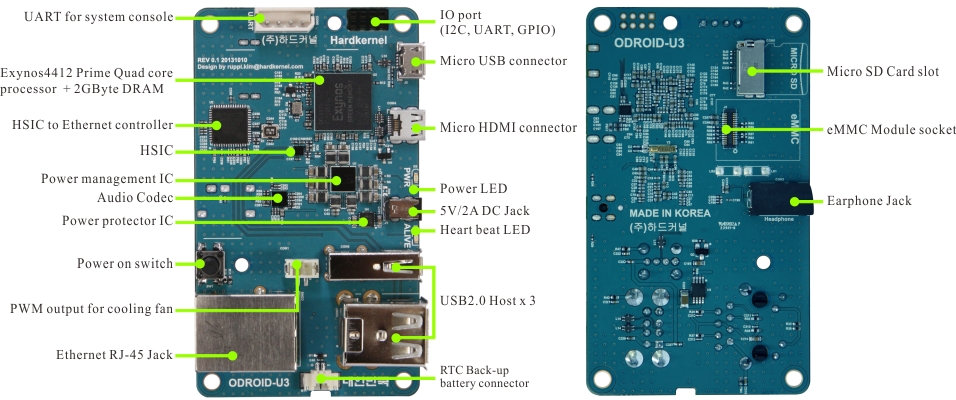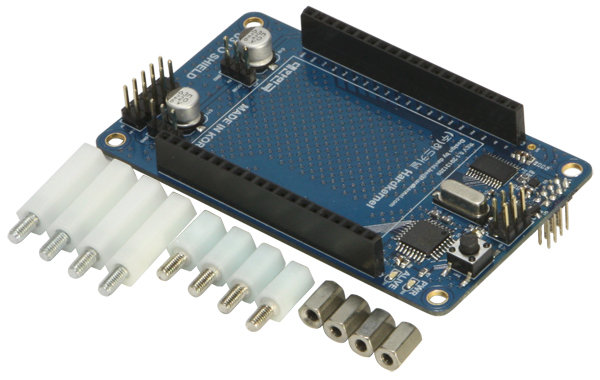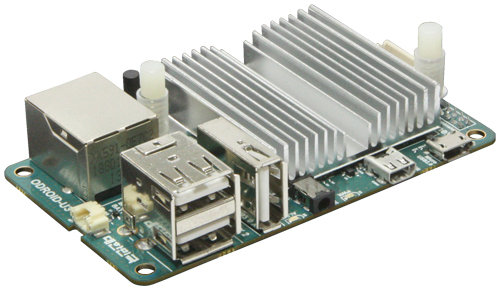Hardkernel ODROID board family already features of the most cost effective development / hobbyist boards in the market. But the company has done it again, with ODROID-U3 a quad core board, software compatible with ODROID-U2, that sells for just $59 + shipping.
ODROID-U3 specifications:
- SoC – Samsung Exynos 4412 Prime @ 1.7 Ghz with ARM Mali-400MP4 GPU @ 440MHz
- System Memory – 2GB @ 880MHz
- Storage – microSD slot, eMMC module socket
- USB – 3x USB 2.0 Host ports, 1x USB 2.0 device for ADB/mass storage
- Ethernet – 10/100Mbps (LAN9730)
- Video Output – micro HDMI
- Audio Output – 3.5mm Jack, micro HDMI
- System Console – UART (1.8Volt)
- DC Power – 5V/2A
- PCB Dimension – 83 x 48mm
- Weight – 48g with heatsink

The company provides images and source code for Xubuntu 13.10, Android 4.x with u-boot 2010.12 and kernel 3.8, as well as the schematics (PDF). Support is available on ODROID-U3 Forums. Compared to the $89 ODROID-U2 board, you’ll get an extra USB port, access to I/Os, a power button, support for external RTC, and better input power protection, but lose the digital microphone. ODROID-U3 is however considerably larger than ODROID-U2 (83 x 48mm vs 48 x 52mm), but it’s still a credit card sized board.

The company is also selling the U3-IO shield ($20) for the board, in order to provide easy access to 36 I/O pins including GPIOs, PWM, and ADC ports. The board has the same size of ODROID-U3, features Atmel ATMega328 and 2 Arduino compatible headers, and schematics (PDF) are available. The board comes with 12 metallic / plastic PCB spacers.
There are actually two version of the board: ODROID-U3 and ODROID-U3 Community Edition. The only difference is the price: $65 for the former, and $59 for the latter, and that you can only order one piece of the community edition version. The company also sell accessories separately for the board including a DC power adapter, a plastic case, a microSD card with Linux or Android, Bluetooth and Wi-Fi modules, a USB-UART board, 8/16 and 64 GB eMMC modules, a micro HDMI cable, a USB IO board, an active cooler, and an RTC backup battery. Shipping is expected for January 14, 2014, and adds $25 to the cost.
You can watch ODROID-U3 presentation video below.

Jean-Luc started CNX Software in 2010 as a part-time endeavor, before quitting his job as a software engineering manager, and starting to write daily news, and reviews full time later in 2011.
Support CNX Software! Donate via cryptocurrencies, become a Patron on Patreon, or purchase goods on Amazon or Aliexpress





